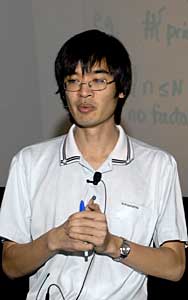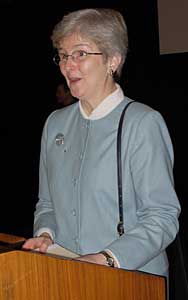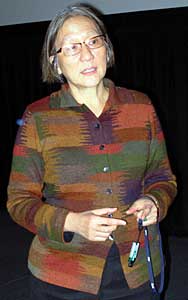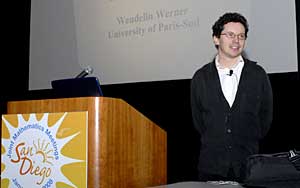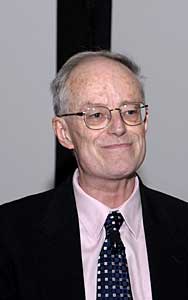
Invited Addresses, Sessions, and Other ActivitiesGetting Your Hands on the Data AMS President James Glimm spearheaded a special session at the Joint Meetings called "The Mathematics of Information and Knowledge." The session was co-organized with Peter W. Jones of Yale University and Steve Smale of the Toyota Institute of Technology at Chicago. The purpose of the session was to focus on the new ways that mathematics is being used in this era of data-rich science and engineering. In the past, applications of mathematics have been dominated by physics problems, with differential equations being among the main tools. The new applications require quite different approaches and center on managing, organizing, and visualizing large and complex data sets. Jones and his Yale colleague Raphael Coifman gave lectures in which they described techniques for creating local coordinate systems that can highlight salient aspects of large data sets. One of the techniques, called "diffusion geometry," works better in many cases than does the traditional statistical tool of principal component analysis. Smale spoke on a new theory he has been developing to understand how, for example, babies learn to identify visual images and to relate them in the correct way even when they have been exposed to a very few examples. The lecture by Walter Willinger of AT&T Labs-Research focused on modeling of the internet. Willinger said that the initial models of the internet coming out of graph theory, such as the preferential attachment model, do not reflect how the internet really operates. The problem was that those models were created without any attention paid to available data. He discussed new alternative models that are emerging, such as the HOT models (heuristically optimized topologies), which take into account network engineering and architecture. The work described in this special session could be the start of a new approach to research. "This is the other side, it's not the mathematics of physics," Glimm said. Instead, mathematicians are dealing directly with data from science and engineering. "It's like riding a horse without a saddle." ---Allyn Jackson
Structure and Randomness in Prime Numbers, by Terence Tao (UCLA)
Now a problem arises from the fact that all numbers are not equally likely to be primes. An obvious example of this is that odd numbers are more likely to be primes than even numbers. This is where the idea of sieving comes in: if one could somehow filter out all the numbers that have “exotic properties” then one would get a set of prime numbers and maybe a random model for them. Tao explained the problems with this idea by talking about the simplest sieve, the Sieve of Erathostenes. By the time one sieves down to the prime numbers, too many error terms have accumulated. But stopping this process earlier (i.e. by the time one gets to the almost primes - numbers with few prime factors or no small factors) gives one good control and a decent random model. The third and final step comes from implementing Szemeredi’s Theorem, which basically says that a “reasonably large” (i.e. positive upper density) set of integers A contains arbitrarily long arithmetic progressions. Tao gave a rough sketch of the proof of this theorem, and in it he mentioned that one basically shows first that A can be modeled by some random model, and then that every random model of a dense set must predict the existence of arithmetic progressions. The combination of these three facts gives the desired result: Dense sets of integers contain progressions (by Szemeredi’s theorem). Primes are not dense in the integers, but they are dense in the almost primes, which obey a good random model. Tao concluded by saying how this result can be reformulated in interesting ways, like given any shape one can find Gaussian primes that give that shape or that the prime numbers contain polynomial progressions. ---Adriana Salerno
SIGMAA on Mathematics and the Arts Panel Discussion, Mathematics and Hollywood: A conversation with mathematical Hollywood writers and mathematics faculty This panel was made up of people with mathematical backgrounds who are on the staffs of shows (Jeff Westbrook of The Simpsons and Ken Keeler of Futurama) and mathematicians who have helped with scripts or with educational efforts connected with shows (David Bressoud of Macalester College, Alice Silverberg of the University of California, Irvine, and Eric Weisstein of Wolfram Research). The organizers, Chris Goff of the University of the Pacific and Sarah Greenwald of Appalachian State University, asked questions of the panelists in the first part of the session and then opened up the session to questions from the audience. In response to a question about panelists' favorite math references on shows, Keeler described how the need for an integer in one episode of Futurama (1729 was used) snowballed into the writers for the show seeking to make each integer on the show "interesting." The show Numb3rs used the name of Silverberg's cat for an encryption algorithm. Weisstein, who along with colleagues at Wolfram is writing equations for Numb3rs, said that Numb3rs did a good job, but that mathematicians should not expect Hollywood's portrayal of mathematicians to be completely real: "Mathematicians have high standards that Hollywood can never live up to and will never live up to." Westbrook, whose background is in computer science and who worked for AT&T Labs, said that his research experiences were similar to his experiences on The Simpsons: Both have people sitting around dreaming things up. The difference? "On The Simpsons, they bring lunch to us." ---Mike Breen
Mathematics and Art: Planar Crystallographic Groups Represented at the Alhambra and Geometric Constructions and Their Arts in Historical Perspective
These images were previously displayed at the July 2007 Bridges Conference on Mathematical Connections in Art, Music and Science. ---Claudia Clark
Fun with Zeta Functions of Graphs, Association for Women in Mathematics Emmy Noether Lecture, by Audrey Terras (University of California, San Diego) The Riemann Zeta function is familiar to most mathematicians. Some important properties of this famous function are that it is a rational function, it satisfies a functional equation, and it’s conjectured to satisfy the Riemann Hypothesis (all of its non-trivial zeros lie on the line Re(s)=1/2). It is notable that there is a duality between primes and the complex zeros of the zeta function. But there are many other versions of the zeta function that show up in other areas of math. The Dedekind zeta function is concerned with number fields and prime ideals. The Selberg zeta function with compact Riemannian manifolds and primitive closed geodesics. In the Emmy Noether Lecture, Audrey Terras introduced the notion of zeta function of a finite, connected, undirected graph with no degree 1 vertices (only one edge coming out) and not necessarily regular (not all vertices have the same degree - or number of edges coming out). The notion of a prime could be defined in this setting as a conjugacy class of specific paths in this graph, called “primitive.” Ihara defined a zeta function using these “primes” in a way that’s very similar to Selberg’s. The interesting thing is that the same questions that one asked in the other settings can be asked again: the Ihara zeta function is the reciprocal of a polynomial, it satisfies a similar functional equation, there is an equivalent prime number theorem and it satisfies the Riemann Hypothesis (for a very special kind of graph, called a Ramanujan graph). A deeper look at this fascinating topic can be found in the draft of a book by Terras on zeta functions. This was yet another worthy installment of the Emmy Noether Lectures, established 29 years ago to honor women mathematicians who have made substantial contributions to mathematics. ---Adriana Salerno
SIGMAA on Business, Industry, and Government Guest Lecture: From Flapping Birds to Space Telescopes: The Modern Science of Origami. Preliminary Report by Robert J. Lang ---Claudia Clark
Clay Mathematics Institute Film Presentation: Julia Robinson and Hilbert’s Tenth Problem, World Premier, produced and directed by George Csicsery The documentary Julia Robinson and Hilbert’s Tenth Problem was presented on Monday evening of the Joint Meetings. Robinson was the first woman to be elected to the mathematical section of the National Academy of Sciences and to serve as president of the American Mathematical Society. As the title suggests, the film focuses on Robinson’s passionate interest and work in mathematics throughout her life, in particular, her work with mathematicians Yuri Matiyasevich, Martin Davis, and Hilary Putnam on Hilbert’s Tenth Problem. Much of the story is told through interviews with these three collaborators, as well as her older sister and biographer, Constance Reid. The film presents some of the personal and professional challenges Robinson faced, including the early death of her parents, childhood illness, and leukemia, which would result in her death at the age of 65. More information about this film is online. ---Claudia Clark
A New Mathematical Frontier: The social and behavioral sciences by Donald G. Saari (University of California, Irvine) The upcoming presidential election is certainly getting a lot of media attention, but who really is thinking about the mathematics behind the whole election process? Donald G. Saari, in his very enlightening lecture, explained how this seemingly straightforward process is much more complex than anyone imagines. For starters, changing voting methods could radically change the outcome of an election. In fact, Saari said, the outcome of an election sometimes says more about which voting method was used than about what voters really want. This leads to the natural question: how can you make sure that an election outcome reflects the voters' preferences? The talk focused on the problem of accurately deciding between three candidates. By analyzing this problem in a more geometric setting, using symmetries of an equilateral triangle, the voting method that holds up more consistently is the Borda count (in which two points are assigned to first-place votes, one for second, and zero for third), and the one with most flaws is the plurality method (in which only votes for first place are counted – ironically, this is the method most widely used in elections). Saari mentioned that there could be important applications of these findings to statistics and economics. He concluded by saying that this is only one example in which mathematics plays a crucial role in understanding and resolving some complexity of society. ---Adriana Salerno
A Mathematician in Congress: Town Hall Meeting with Member of Congress Jerry McNerney (D-CA) sponsored by the AMS Committee on Science and Social Policy Jerry McNerney, the only member of the U.S. House of Representatives who holds a Ph.D. in mathematics, spent a day at the Joint Mathematics Meetings, where he spoke at a session on climate change and conducted a town meeting in which he took questions from the audience. After receiving his doctorate from the University of New Mexico, McNerney worked at Sandia National Laboratories and US Windpower, and later became an energy consultant. McNerney now represents the 11th District of California in Congress. He has been an advocate for, among other issues, science, technology, engineering, and mathematics (STEM) education; alternative energy; and stem cell research. McNerney spoke about his work as a member of several committees, including the Committee on Science and Technology, the Select Committee on Energy Independence and Global Warming, and the Committee on Transportation and Infrastructure. He discussed some of the specific issues that need to be addressed, such as STEM research and education. For example, he noted that the American COMPETES Act was funded at levels far below what was originally authorized, reflecting an ongoing problem of long-term needs being slighted in favor of short-term needs. McNerney said that one of his main goals in Congress is to support research towards cleaner and more efficient energy, and he urged mathematicians to get involved in the research that underpins this effort. McNerney then answered questions from the audience on such topics as “No Child Left Behind,” wind energy, H1 visas, and campaign finance reform. Some of the questions focused on public perceptions of mathematics. Although mathematics is respected, he said, it is sometimes regarded merely as an academic exercise that does not contribute much. "We need more awareness of the power that mathematics brings to the table," he said. He also talked about the lack of rational discourse on Capitol Hill, where emotional appeals, grandstanding, territorial jockeying, and personal relationships are what decide political battles. "Rational argumentation is way down on the list"---a state of affairs he would like to change. Other questions addressed education, and McNerney acknowledged the big problems in this area. But he also noted that "there has to be an outcry in this country" before any substantial changes can be made in education, and there is no such outcry from the public. He said, "We need to make this country more aware of the importance of education." McNerney urged audience members who want their congressional representatives to support an issue such as STEM research and education to do the following:
Read an interview with McNerney in the October 2007 issue of the Notices. ---Claudia Clark and Allyn Jackson
Other Invited Address pictures:
|


